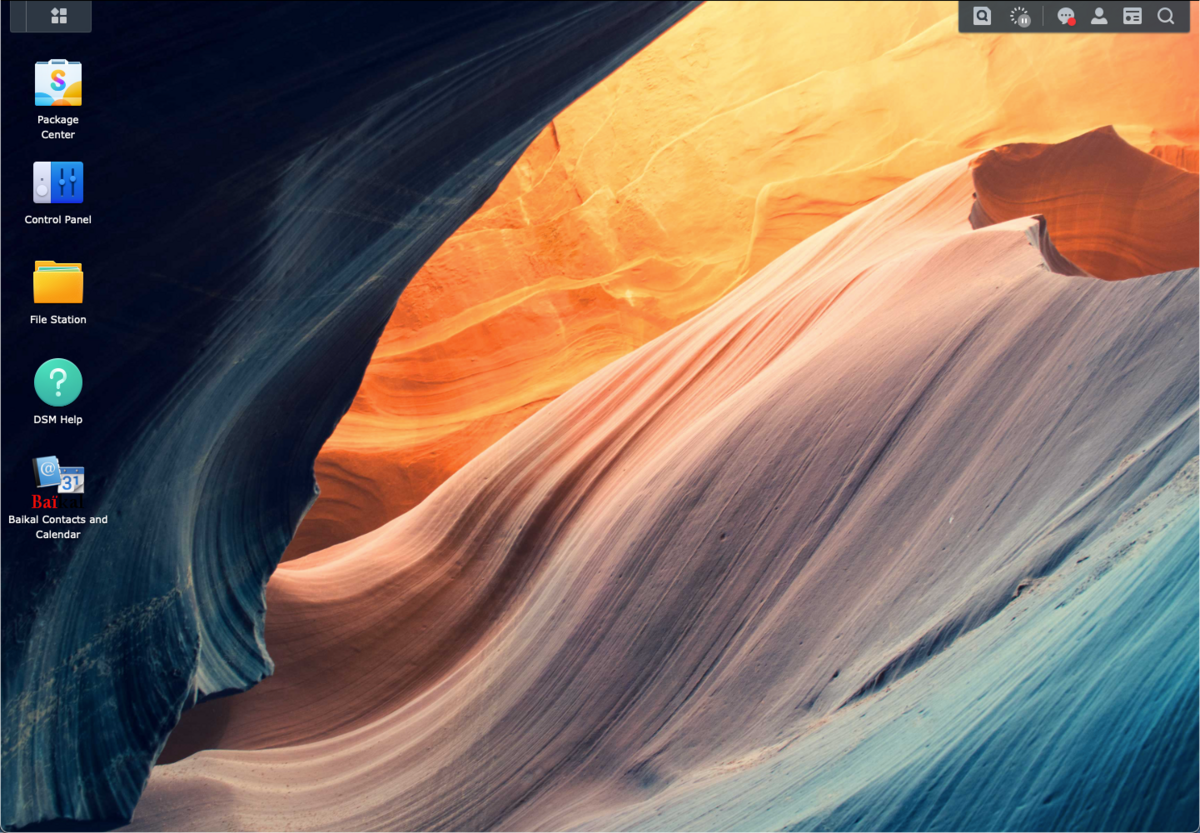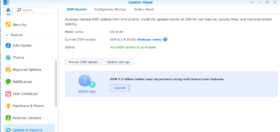Synology: Upgrade to DSM7 - Baikal will work nicely!
-
Steffi -
August 23, 2021 at 4:00 PM -
5,784 Views -
0 Comments -
8 Minutes

- Yes, I know it has been quiet here at my blog but it has a reason: Currently, I am studying to improve my knowledge which in return will benefit you in regards of secure your own cloud and much more. Therefore, I invest loads of time to gain my new qualification.
- If you are interested how I will gain my OSCP then please let me know and write a commend below.
- Upgrade or rather not
- What are the changes?
- Backup and migration
- Upgrade to DSM 7
- Done - Upgrade to DSM7 completed
- Recover baikal and your contacts/calendars
Yes, I know it has been quiet here at my blog but it has a reason: Currently, I am studying to improve my knowledge which in return will benefit you in regards of secure your own cloud and much more. Therefore, I invest loads of time to gain my new qualification.
If you are interested how I will gain my OSCP then please let me know and write a commend below.
But now back to the main subject - Upgrading your own cloud to DSM 7.
I believe there are already thousands of posts out there which will show you how to upgrade your Synology to DSM7 but none covers your Baikal and MariaDB10 installation and how to use it under DSM 7. There is a real hype around DSM 7 but I think it is not too bad.
My personal strategy to overcome big upgrades include:
- Take a break and a coffee
- Collect all information about the upgrade and try to understand what it does
- Take notes in DT3, Tinderbox, Notebooks and ZoomNotes - at the end of the day every single note will give you the big picture
- Before, I will write something on the blog, I will test it beforehand, so that I am sure it will work.
Upgrade or rather not
I have got several requests and comments if you should do an upgrade to the latest version or rather wait until everything had been settled.
My opinion is: Yes, do it! Because you will not miss out of several security features in the new release nor new updates for your antivirus app and much more.
Personally, I dislike the UI as I think it is too much but well, it is modern and suits most people out there.
The speed of your Synology under DSM 7 has been increased significantly and also the protection of your own cloud. At the downside, the RAM usage has been increased by roughly 20%.
Anyhow, if you like to upgrade you should visit the websites of Synology ( https://www.synology.com/ ) to see which apps will not be supported anymore and which devices can be upgraded. Much easier to see the out-of-service packages is the download center at Synology https://www.synology.com/ . Under EOL you can see all discontinued packages.
I spent quite a week or so to fully understand the new upgrade and it's implication on running systems and what to do to avoid any issues. The upgrade worked nicely then I updated my client's systems and there were no issues at all. Preparation is key!
What are the changes?
Before the actual upgrade begins, you will get several notifications of discontinued packages or installation of your Synology. You ought to get them sorted before upgrading your system. Some apps and information are:
- Downgrade is not possible
Well at least states Synology's website so but there is workaround. - CloudSync will not work anmore
You should upgrade to SynologyDrive beforehand - SMB for Windows
Here you should have already upgraded to version 2 or 3 from version 1. Version 1 will not be supported anymore. - Photo app is gone too
You can download the latest release of Synology Photos from the package manager. Please use under iOS also the new app called "Synology Photos" - MariaDB5 will not work anymore
If you still use MariaDB5 you need to upgrade to MariaDB10
How to do this - see below
- Java und Python3
Java will not be supported anymore as there Python3 is now included in DSM - Websites
Do you run a website on your Synology? Then the URL and location of it will change.
Surely, there are other changes too but I think that are the main changes. All apps which are not longer supported should be deinstalled before upgrading your Synology.
Backup, upgrade, databases
Before upgrading you should have a backup to hand if something happens which should not. So, you can restore quickly your Synology in that case.
Upgrading MariaDB5 to MariaDB10
It is important, that you install both versions of MariaDB and start/stop them using the package center. Change the password of MariaDB10 using the package center and stop the service in the meantime.
Important to know: is that the port will change from 3306 to 3307 and your password needs now special characters. Further to this, some application, like feeds or so, do not work with localhost anymore - instead use 127.0.0.1 like 127.0.0.1:3307
You can open Baikal's admin interface and browse to Settings and change the port, user and password for MariaDB10. As the service is stopped and no data are in MariaDB10 you might get an error.
Backup and migration
I trust, there are several ways to backup a database and restore it. However, if you use phpMyAdmin there will be issues as the file is too big or the upload time has been expired. Therefore, I use the Terminal as it is much easier.
Open you terminal and type the following command:
ssh benutzer@IP
before, you should activate ssh-services in the setting of your Synology. After pressing Enter your password needs to be entered.
Create backup
Using the following command your databases will be written to a file ending with sql:
mysqldump -u user -p –all-databases > /volumeNumber/Path
user: is the user for your databases. Most in the cases it is root or admin. However, for your security you should think about change them.
-p password
–all-databases : all databases will be included in the backup
> is for output
/volumeNumber/Path- is the location of your destination using one of your volumes.
If you are not sure which volume number is the right one, then go to Settings > Shared folders. Here you will see the volume number.
The command look then like:
mysqldump -u root -p –all-databases > /volume1/data/backup
Press enter and use the password for MariaDB5 and wait a while until the backup is done.
You can check the file using the FileStation and the Path used.
After this you will stop MariaDB5 and start MariaDB10 for migration.
Migrate to MariaDB10
Now, you will use this command to migrate your databases:
MySQL -u root - p </PathThereYourBackupIs/backup.sql
Press Enter and use the password for MariaDB10
As mentioned below:
-u for user
-p password
< migrate to MariaDB10.
Changing paths for your databases in Baikal
For Baikal you can use the FileStation at the location auf web/http://baikal.app/Specific/config.system.php. This file can be opened using the TextEditor and you will need to change line 57 through 60:
locahost:3307
database name
user (hopefully not root ![]() )
)
password.
Save the file this connection is done. After that you should update the Framework file in web/http://baikal.app/Core/Frameworks/Baikal and /BaikalAdmin.
After this, you can use Baikal as usual but this time using MariaDB10.
Your feeds:
If you have FreshRSS installed, you can enter the new credentials in web/data/config. Please use 127.0.0.1:3307 instead of localhost.
Now, you can deinstall MariaDB5 in the Package center.
Upgrade to DSM 7
After preparing your system, we can now install the upgrade which will take approximately two hours. However, it took me 45 minutes.
Tip: Please keep on the site of the upgrade even it shows you "Restart in x minutes". If you like to see your upgrade, you should copy the URL and paste it into another tab of your browser.
Here are several screenshots to the upgrade:
Done - Upgrade to DSM7 completed
Well, now it is done and I do hope everything worked out for your.
At my first upgrade I thought it is Windows as all settings for update etc. had been changed by the upgrade.
I recommend to view the following settings and if you do not want them change them:
- Updates
- Synology QuickConnect
- Password policies
- Theme and login pages
After this, please go to the Package Center and repair all apps which are displayed, like:
- Virtueller MaschineManager
- Synology Photo
- Antivirus - Update.
Some apps can be deinstalled:
- Python3
This is now included in DSM7 - Baikal (Version 0.2 oder 0.4)
Please leave it for the meantime - Apps, which are mentioned on Synology's website and which are not longer supported.
Now, it is done!
Recover baikal and your contacts/calendars
The service for Baikal was stopped and you will see an exclamation mark right on the icon. However, Baikal is a php-web-application which will be executed as soon as it is requested.
The new phpMyAdmin package was now transfered from web to web_packages but Baikal can stay there it is.
The WebStation and how website will be handled has been changed in DSM 7. The easiest way to activate Baikal is to change the folder in /web/
from baikal_app to baikal.
The icon with of Baikal will work using the right mouse key - open in new tab. This will open the Baikal admin page.
or after changing the INFO file for Baikal it will look like:
If you prefer to have the icon without the exclamation mark, you need to dive deep in Synology's package enviorment. Here you will find a file called INFO which you can edit and change it to the new settings which are:
install_dep_services
start_dep_services
instuninst_restart_services
dsmappname
The sub directory "thirdparty" has been changed to "3rdparty" which needs to be changed.
The path to the file is /var/packages/baikal/INFO
After updating the file, you can now just click on the icon and it will lead to the login page of Baikal.
In order to check if Baikal runs, you go to
and with 'https://IPAdresse/baikal/admin' you can login.
Why does it work this way?
Baikal is web-based meaning the underlying environment is php-based and as long Apache 2.2 or 2.4 runs, it application will too.
Personally, I am not bothered with the icon and the notice in the Package center. But if it disturb you, you can:
- Backup /web/baikal.app
- Remove Baikal from Package center
- Copy your backup to /web or /web_packages folder
- Generate a link using URL: 'https://IPAdresse/baikal/admin/' or bookmark it in you browser.
Deinstalling Baikal will update the package center and underlying DPKG files in Linux but Baikal will run nevertheless.
I hope, you are happy to know what you can use Baikal even on DSM7 and enjoyed this tutorial.
If you have question please use the comment below.















Comments
Newly created comments need to be manually approved before publication, other users cannot see this comment until it has been approved.
Newly created comments need to be manually approved before publication, other users cannot see this comment until it has been approved.